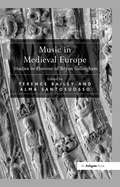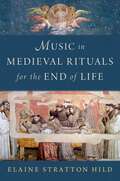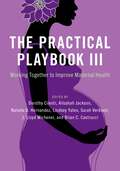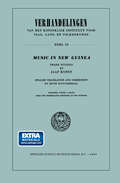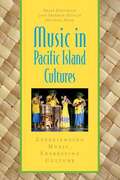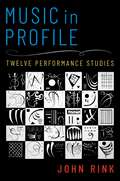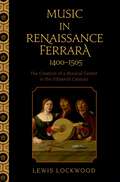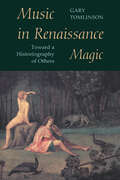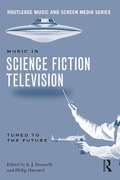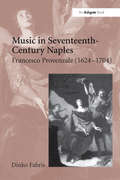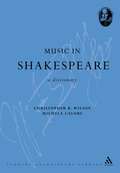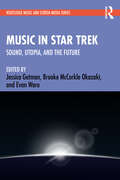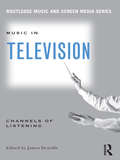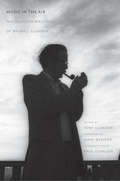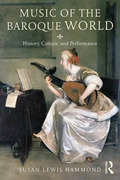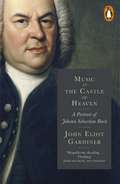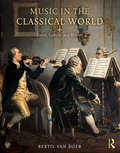- Table View
- List View
Music in Medieval Europe: Studies in Honour of Bryan Gillingham
by Alma SantosuossoThis book presents the most recent findings of twenty of the foremost European and North American researchers into the music of the Middle Ages. The chronological scope of their topics is wide, from the ninth to the fifteenth century. Wide too is the range of the subject matter: included are essays on ecclesiastical chant, early and late (and on the earliest and latest of its supernumerary tropes, monophonic and polyphonic); on the innovative and seminal polyphony of Notre-Dame de Paris, and the Latin poetry associated with the great cathedral; on the liturgy of Paris, Rome and Milan; on musical theory; on the emotional reception of music near the end of the medieval period and the emergence of modern sensibilities; even on methods of encoding the melodies that survive from the Middle Ages, encoding that makes it practical to apply computer-assisted analysis to their vast number. The findings presented in this book will be of interest to those engaged by music and the liturgy, active researchers and students. All the papers are carefully and extensively documented by references to medieval sources.
Music in Medieval Rituals for the End of Life
by Elaine Stratton HildFor centuries of European history, singing for a person at the moment of death was considered to be the ideal accompaniment to a life's ending. In Music in Medieval Rituals for the End of Life, author Elaine Stratton Hild examines and recovers the chants sung for the dying during the Middle Ages, beginning in the late eighth century. Along with the first editions of these melodies, she offers considerations of the functions that music played within the deathbed rituals, arguing that the chants served as vehicles with which communities offered comfort to a dying person. The book presents close readings of rituals from diverse communities, each as they appear in a single source. The rituals' chants are transcribed into modern notation and analyzed, both for their text-music relationships and for their functions within the rituals. Hild shows that within the widespread practice, local versions of the liturgies--along with their chant repertories--remained unstandardized throughout the Middle Ages. Yet some commonalities are evident among these varied local practices. One is the use of song. Beginning in the ninth century, sources most often prescribe chant, not the Eucharist, for the final moments of life. Another commonality is the positive depiction of the afterlife conveyed by the chants. Created for the powerful and the poor, the educated and the uneducated, women and men, monastics, clerics, and laity, these manuscripts offer a glimpse into the religious practices that distinguished communities from one another and also bound them together within a single tradition.
Music in Medieval Rituals for the End of Life
by Elaine Stratton HildFor centuries of European history, singing for a person at the moment of death was considered to be the ideal accompaniment to a life's ending. In Music in Medieval Rituals for the End of Life, author Elaine Stratton Hild examines and recovers the chants sung for the dying during the Middle Ages, beginning in the late eighth century. Along with the first editions of these melodies, she offers considerations of the functions that music played within the deathbed rituals, arguing that the chants served as vehicles with which communities offered comfort to a dying person. The book presents close readings of rituals from diverse communities, each as they appear in a single source. The rituals' chants are transcribed into modern notation and analyzed, both for their text-music relationships and for their functions within the rituals. Hild shows that within the widespread practice, local versions of the liturgies--along with their chant repertories--remained unstandardized throughout the Middle Ages. Yet some commonalities are evident among these varied local practices. One is the use of song. Beginning in the ninth century, sources most often prescribe chant, not the Eucharist, for the final moments of life. Another commonality is the positive depiction of the afterlife conveyed by the chants. Created for the powerful and the poor, the educated and the uneducated, women and men, monastics, clerics, and laity, these manuscripts offer a glimpse into the religious practices that distinguished communities from one another and also bound them together within a single tradition.
Music in New Guinea: Three Studies (Verhandelingen van het Koninklijk Instituut voor Taal-, Land- en Volkenkunde)
by Jaap KunstMusic in Pacific Island Cultures: Experiencing Music, Expressing Culture
by Brian Diettrich Jane Freeman Moulin Michael WebbMusic in Profile: Twelve Performance Studies
by John RinkUnderpinned by author John Rink's internationally acclaimed scholarship and experience as a musician, this book addresses fascinating topics in the field of musical performance studies concerning the history, analysis and psychology of music, as well as artistic research. It offers manifold practical insights into musical performance, ranging from detailed technical features to overall shape. The volume has four main parts, focusing on performance and performance studies, historical performance, analysis and performance, and artistic research. Case studies of romantic piano pieces appear throughout, including Liszt's 'Vall?e d'Obermann', Brahms's Fantasien Op. 116, and select preludes and concertos by Rachmaninoff and Chopin. The book also includes discussions of recordings by such artists as Alfred Brendel, Artur Rubinstein and Nikita Magaloff along with some outstanding performances in the International Fryderyk Chopin Piano Competition in 2015. Rink explores issues surrounding the identity and artistic voice of the performer by elucidating the sense-making and decision-making process underlying musical performance of all kinds. He also offers broad insights into musical ontology, epistemology and semantics, in addition to demonstrating some of the methodologies now used to study performance. As a whole, the book highlights the powerful effects that experiencing music in performance can have on those who take part in it, in any capacity.
Music in Profile: Twelve Performance Studies
by John RinkUnderpinned by author John Rink's internationally acclaimed scholarship and experience as a musician, this book addresses fascinating topics in the field of musical performance studies concerning the history, analysis and psychology of music, as well as artistic research. It offers manifold practical insights into musical performance, ranging from detailed technical features to overall shape. The volume has four main parts, focusing on performance and performance studies, historical performance, analysis and performance, and artistic research. Case studies of romantic piano pieces appear throughout, including Liszt's 'Vall?e d'Obermann', Brahms's Fantasien Op. 116, and select preludes and concertos by Rachmaninoff and Chopin. The book also includes discussions of recordings by such artists as Alfred Brendel, Artur Rubinstein and Nikita Magaloff along with some outstanding performances in the International Fryderyk Chopin Piano Competition in 2015. Rink explores issues surrounding the identity and artistic voice of the performer by elucidating the sense-making and decision-making process underlying musical performance of all kinds. He also offers broad insights into musical ontology, epistemology and semantics, in addition to demonstrating some of the methodologies now used to study performance. As a whole, the book highlights the powerful effects that experiencing music in performance can have on those who take part in it, in any capacity.
Music in Renaissance Ferrara 1400-1505: The Creation of a Musical Center in the Fifteenth Century
by Lewis LockwoodBased on extensive documentary and archival research, Music in Renaissance Ferrara is a documentary history of music for one of the most important city-states of the Italian Renaissance. Lockwood shows how patrons and musicians created a musical center over the course of the fifteenth-century, tracing the growth of music and musical life in rich detail. It also sheds new light on the careers of such important composers as Dufay, Martini, Obrecht, and Josquin Desprez. This paperback edition features a new preface that re-introduces the book and reflects on its contribution to our modern knowledge of music in the culture of the Italian Renaissance.
Music in Renaissance Magic: Toward a Historiography of Others
by Gary TomlinsonMagic enjoyed a vigorous revival in sixteenth-century Europe, attaining a prestige lost for over a millennium and becoming, for some, a kind of universal philosophy. Renaissance music also suggested a form of universal knowledge through renewed interest in two ancient themes: the Pythagorean and Platonic "harmony of the celestial spheres" and the legendary effects of the music of bards like Orpheus, Arion, and David. In this climate, Renaissance philosophers drew many new and provocative connections between music and the occult sciences. In Music in Renaissance Magic, Gary Tomlinson describes some of these connections and offers a fresh view of the development of early modern thought in Italy. Raising issues essential to postmodern historiography—issues of cultural distance and our relationship to the others who inhabit our constructions of the past —Tomlinson provides a rich store of ideas for students of early modern culture, for musicologists, and for historians of philosophy, science, and religion. "A scholarly step toward a goal that many composers have aimed for: to rescue the idea of New Age Music—that music can promote spiritual well-being—from the New Ageists who have reduced it to a level of sonic wallpaper."—Kyle Gann, Village Voice "An exemplary piece of musical and intellectual history, of interest to all students of the Renaissance as well as musicologists. . . . The author deserves congratulations for introducing this new approach to the study of Renaissance music."—Peter Burke, NOTES "Gary Tomlinson's Music in Renaissance Magic: Toward a Historiography of Others examines the 'otherness' of magical cosmology. . . . [A] passionate, eloquently melancholy, and important book."—Anne Lake Prescott, Studies in English Literature
Music In Renaissance Magic: Toward A Historiography Of Others
by Gary TomlinsonMagic enjoyed a vigorous revival in sixteenth-century Europe, attaining a prestige lost for over a millennium and becoming, for some, a kind of universal philosophy. Renaissance music also suggested a form of universal knowledge through renewed interest in two ancient themes: the Pythagorean and Platonic "harmony of the celestial spheres" and the legendary effects of the music of bards like Orpheus, Arion, and David. In this climate, Renaissance philosophers drew many new and provocative connections between music and the occult sciences. In Music in Renaissance Magic, Gary Tomlinson describes some of these connections and offers a fresh view of the development of early modern thought in Italy. Raising issues essential to postmodern historiography--issues of cultural distance and our relationship to the others who inhabit our constructions of the past --Tomlinson provides a rich store of ideas for students of early modern culture, for musicologists, and for historians of philosophy, science, and religion. "A scholarly step toward a goal that many composers have aimed for: to rescue the idea of New Age Music--that music can promote spiritual well-being--from the New Ageists who have reduced it to a level of sonic wallpaper."--Kyle Gann, Village Voice "An exemplary piece of musical and intellectual history, of interest to all students of the Renaissance as well as musicologists. . . . The author deserves congratulations for introducing this new approach to the study of Renaissance music."--Peter Burke, NOTES "Gary Tomlinson's Music in Renaissance Magic: Toward a Historiography of Others examines the 'otherness' of magical cosmology. . . . [A] passionate, eloquently melancholy, and important book."--Anne Lake Prescott, Studies in English Literature
Music in Science Fiction Television: Tuned to the Future
by K. J. Donnelly Philip HaywardThe music for science fiction television programs, like music for science fiction films, is often highly distinctive, introducing cutting-edge electronic music and soundscapes. There is a highly particular role for sound and music in science fiction, because it regularly has to expand the vistas and imagination of the shows and plays a crucial role in setting up the time and place. Notable for its adoption of electronic instruments and integration of music and effects, science fiction programs explore sonic capabilities offered through the evolution of sound technology and design, which has allowed for the precise control and creation of unique and otherworldly sounds. This collection of essays analyzes the style and context of music and sound design in Science Fiction television. It provides a wide range of in-depth analyses of seminal live-action series such as Doctor Who, The Twilight Zone, and Lost, as well as animated series, such as The Jetsons. With thirteen essays from prominent contributors in the field of music and screen media, this anthology will appeal to students of Music and Media, as well as fans of science fiction television.
Music in Science Fiction Television: Tuned to the Future
by K. J. Donnelly Philip HaywardThe music for science fiction television programs, like music for science fiction films, is often highly distinctive, introducing cutting-edge electronic music and soundscapes. There is a highly particular role for sound and music in science fiction, because it regularly has to expand the vistas and imagination of the shows and plays a crucial role in setting up the time and place. Notable for its adoption of electronic instruments and integration of music and effects, science fiction programs explore sonic capabilities offered through the evolution of sound technology and design, which has allowed for the precise control and creation of unique and otherworldly sounds. This collection of essays analyzes the style and context of music and sound design in Science Fiction television. It provides a wide range of in-depth analyses of seminal live-action series such as Doctor Who, The Twilight Zone, and Lost, as well as animated series, such as The Jetsons. With thirteen essays from prominent contributors in the field of music and screen media, this anthology will appeal to students of Music and Media, as well as fans of science fiction television.
Music in Seventeenth-Century Naples: Francesco Provenzale (1624-1704)
by Dinko FabrisThe most important figure of seventeenth-century Neapolitan music, Francesco Provenzale (1624-1704) spent his long life in the service of a number of Neapolitan conservatories and churches, culminating in his appointment as maestro of the Tesoro di S. Gennaro and the Real Cappella. Provenzale was successful in generating significant profit from a range of musical activities promoted by him with the participation of his pupils and trusted collaborators. Dinko Fabris draws on newly discovered archival documents to reconstruct the career of a musician who became the leader of his musical world, despite his relatively small musical output. The book examines Provenzale's surviving works alongside those of his most important Neapolitan contemporaries (Raimo Di Bartolo, Sabino, Salvatore and Caresana) and pupils (Fago, Greco, Veneziano and many others), revealing both stylistic similarities and differences, particularly in terms of new harmonic practices and the use of Neapolitan language in opera. Fabris provides both a life and works study of Provenzale and a conspectus of Neapolitan musical life of the seventeenth century which so clearly laid the groundwork for Naples' later status as one of the great musical capitals of Europe.
Music in Seventeenth-Century Naples: Francesco Provenzale (1624-1704)
by Dinko FabrisThe most important figure of seventeenth-century Neapolitan music, Francesco Provenzale (1624-1704) spent his long life in the service of a number of Neapolitan conservatories and churches, culminating in his appointment as maestro of the Tesoro di S. Gennaro and the Real Cappella. Provenzale was successful in generating significant profit from a range of musical activities promoted by him with the participation of his pupils and trusted collaborators. Dinko Fabris draws on newly discovered archival documents to reconstruct the career of a musician who became the leader of his musical world, despite his relatively small musical output. The book examines Provenzale's surviving works alongside those of his most important Neapolitan contemporaries (Raimo Di Bartolo, Sabino, Salvatore and Caresana) and pupils (Fago, Greco, Veneziano and many others), revealing both stylistic similarities and differences, particularly in terms of new harmonic practices and the use of Neapolitan language in opera. Fabris provides both a life and works study of Provenzale and a conspectus of Neapolitan musical life of the seventeenth century which so clearly laid the groundwork for Naples' later status as one of the great musical capitals of Europe.
Music in Shakespeare: A Dictionary (Continuum Shakespeare Dictionaries)
by Christopher R. Wilson Michela CaloreMusical references, allusions to music, and music stage directions abound in Shakespeare, ranging from simple trumpet flourishes to sophisticated, philosophical allegory. Music in Shakespeare: A Dictionary identifies all musical terms found in the Shakespeare canon. An A-Z of over 300 entries includes a definition of each musical term in its historical and theoretical context, and explores the extent of Shakespeare's use of musical imagery across the full range of his dramatic and poetic work. Music in Shakespeare also analyses the usage of musical instruments and sound effects on the Shakespearean stage, providing descriptions of the instruments employed in the Elizabethan and Jacobean theatres. This is a comprehensive reference guide for scholars and students with interests ranging from the thematic and allegorical relevance of music in Shakespeare's works to the history of performance. It is also aimed at the growing number of directors and actors concerned with recovering the staging conditions of the early modern theatre.
Music in Star Trek: Sound, Utopia, and the Future
by Jessica Getman Brooke McCorkle Okazaki Evan WareThe tensions between utopian dreams and dystopian anxieties permeate science fiction as a genre, and nowhere is this tension more evident than in Star Trek. This book breaks new ground by exploring music and sound within the Star Trek franchise across decades and media, offering the first sustained look at the role of music in shaping this influential series. The chapters in this edited collection consider how the aural, visual, and narrative components of Star Trek combine as it constructs and deconstructs the utopian and dystopian, shedding new light on the series’ political, cultural, and aesthetic impact. Considering how the music of Star Trek defines and interprets religion, ideology, artificial intelligence, and more, while also considering fan interactions with the show’s audio, this book will be of interest to students and scholars of music, media studies, science fiction, and popular culture.
Music in Star Trek: Sound, Utopia, and the Future
by Jessica Getman Brooke McCorkle Okazaki Evan WareThe tensions between utopian dreams and dystopian anxieties permeate science fiction as a genre, and nowhere is this tension more evident than in Star Trek. This book breaks new ground by exploring music and sound within the Star Trek franchise across decades and media, offering the first sustained look at the role of music in shaping this influential series. The chapters in this edited collection consider how the aural, visual, and narrative components of Star Trek combine as it constructs and deconstructs the utopian and dystopian, shedding new light on the series’ political, cultural, and aesthetic impact. Considering how the music of Star Trek defines and interprets religion, ideology, artificial intelligence, and more, while also considering fan interactions with the show’s audio, this book will be of interest to students and scholars of music, media studies, science fiction, and popular culture.
Music in Television: Channels of Listening
by James DeavilleMusic in Television is a collection of essays examining television’s production of meaning through music in terms of historical contexts, institutional frameworks, broadcast practices, technologies, and aesthetics. It presents the reader with overviews of major genres and issues, as well as specific case studies of important television programs and events. With contributions from a wide range of scholars, the essays range from historical-analytical surveys of TV sound and genre designations to studies of the music in individual programs, including South Park and Dr. Who.
Music in Television: Channels of Listening
by James DeavilleMusic in Television is a collection of essays examining television’s production of meaning through music in terms of historical contexts, institutional frameworks, broadcast practices, technologies, and aesthetics. It presents the reader with overviews of major genres and issues, as well as specific case studies of important television programs and events. With contributions from a wide range of scholars, the essays range from historical-analytical surveys of TV sound and genre designations to studies of the music in individual programs, including South Park and Dr. Who.
Music in the Air: The Selected Writings of Ralph J. Gleason
by Ralph J. GleasonThe co-founder of Rolling Stone magazine, Ralph J. Gleason was among the most respected journalists, interviewers, and critics writing about popular music in the latter half of the twentieth century. As a longtime contributor to the San Francisco Chronicle, Down Beat, and Ramparts, his expertise and insights about music, musicians, and cultural trends were unparalleled, whether his subject was jazz, folk, pop, or rock and roll. He was the only music journalist included on President Richard Nixon’s infamous “Enemies List,” which Gleason himself considered “the highest honor a man’s country can bestow upon him.” This sterling anthology, edited by Gleason’s son Toby, himself a forty-year veteran of the music business, spans Ralph J. Gleason’s four decades as popular music’s preeminent commentator. Drawing from a rich variety of sources, including Gleason’s books, essays, interviews, and LP record album liner notes, it is essential reading for writers, historians, scholars, and music lovers of every stripe.
Music in the Baroque World: History, Culture, and Performance
by Susan Lewis HammondMusic in the Baroque World: History, Culture, Performance offers an interdisciplinary study of the music of Europe and the Americas in the seventeenth and first half of the eighteenth centuries. It answers calls for an approach that balances culture, history, and musical analysis, with an emphasis on performance considerations such as notation, instruments, and performance techniques. It situates musical events in their intellectual, social, religious, and political contexts and enables in-depth discussion and critical analysis. Features An interdisciplinary approach that balances detailed analysis of specific pieces of music and broader historical overview and relevance A selection of historical documents at the end of each chapter that position musical works and events in their cultural context Extensive musical examples that show the melodic, textural, harmonic, or structural features of baroque music and enhance the utility of the textbook for undergraduate and graduate music majors A global perspective with a chapter on Music in the Americas A companion score anthology and website with links to audio/video content of key performances and research and writing guides Music in the Baroque World: History, Culture, Performance tells stories of local traditions, cultural exchange, performance trends, and artistic mixing. It illuminates representative works through the lens of politics, visual arts, theology, print culture, gender, domesticity, commerce, and cultural influence and exchange.
Music in the Baroque World: History, Culture, and Performance
by Susan Lewis HammondMusic in the Baroque World: History, Culture, Performance offers an interdisciplinary study of the music of Europe and the Americas in the seventeenth and first half of the eighteenth centuries. It answers calls for an approach that balances culture, history, and musical analysis, with an emphasis on performance considerations such as notation, instruments, and performance techniques. It situates musical events in their intellectual, social, religious, and political contexts and enables in-depth discussion and critical analysis. Features An interdisciplinary approach that balances detailed analysis of specific pieces of music and broader historical overview and relevance A selection of historical documents at the end of each chapter that position musical works and events in their cultural context Extensive musical examples that show the melodic, textural, harmonic, or structural features of baroque music and enhance the utility of the textbook for undergraduate and graduate music majors A global perspective with a chapter on Music in the Americas A companion score anthology and website with links to audio/video content of key performances and research and writing guides Music in the Baroque World: History, Culture, Performance tells stories of local traditions, cultural exchange, performance trends, and artistic mixing. It illuminates representative works through the lens of politics, visual arts, theology, print culture, gender, domesticity, commerce, and cultural influence and exchange.
Music in the Castle of Heaven: A Portrait of Johann Sebastian Bach
by John Eliot GardinerJohann Sebastian Bach is one of the most unfathomable composers in the history of music. How can such sublime work have been produced by a man who (when we can discern his personality at all) seems so ordinary, so opaque - and occasionally so intemperate?John Eliot Gardiner grew up passing one of the only two authentic portraits of Bach every morning and evening on the stairs of his parents' house, where it hung for safety during the Second World War. He has been studying and performing Bach ever since, and is now regarded as one of the composer's greatest living interpreters. The fruits of this lifetime's immersion are distilled in this remarkable book, grounded in the most recent Bach scholarship but moving far beyond it, which explains in wonderful detail the ideas on which Bach drew, how he worked, how his music is constructed, how it achieves its effects - and what it can tell us about Bach the man.Gardiner's background as a historian has encouraged him to search for ways in which scholarship and performance can cooperate and fruitfully coalesce. This has entailed piecing together the few biographical shards, scrutinising the music, and watching for those instances when Bach's personality seems to penetrate the fabric of his notation. Gardiner's aim is 'to give the reader a sense of inhabiting the same experiences and sensations that Bach might have had in the act of music-making. This, I try to show, can help us arrive at a more human likeness discernible in the closely related processes of composing and performing his music.'It is very rare that such an accomplished performer of music should also be a considerable writer and thinker about it. John Eliot Gardiner takes us as deeply into Bach's works and mind as perhaps words can. The result is a unique book about one of the greatest of all creative artists.SIR JOHN ELIOT GARDINER is one of the world's leading conductors, not only of Baroque music but across the whole repertoire. He founded the Monteverdi Choir and Orchestra, the Orchestre de l'Opéra de Lyon, the English Baroque Soloists, and the Orchestre Revolutionnaire et Romantique. He has conducted most of the world's great orchestras and in many of the leading opera houses. He lives and farms in Dorset.
Music in the Classical World: Genre, Culture, and History
by Bertil van BoerMusic in the Classical World: Genre, Culture, and History provides a broad sociocultural and historical perspective of the music of the Classical Period as it relates to the world in which it was created. It establishes a background on the time span—1725 to 1815—offering a context for the music made during one of the more vibrant periods of achievement in history. Outlining how music interacted with society, politics, and the arts of that time, this kaleidescopic approach presents an overview of how the various genres expanded during the period, not just in the major musical centers but around the globe. Contemporaneous treatises and commentary documenting these changes are integrated into the narrative. Features include the following: A complete course with musical scores on the companion website, plus links to recordings—and no need to purchase a separate anthology The development of style and genres within a broader historical framework Extensive musical examples from a wide range of composers, considered in context of the genre A thorough collection of illustrations, iconography, and art relevant to the music of the age Source documents translated by the author Valuable student learning aids throughout, including a timeline, a register of people and dates, sidebars of political importance, and a selected reading list arranged by chapter and topic A companion website featuring scores of all music discussed in the text, recordings of most musical examples, and tips for listening Music in the Classical World: Genre, Culture, and History tells the story of classical music through eighteenth-century eyes, exposing readers to the wealth of music and musical styles of the time and providing a glimpse into that vibrant and active world of the Classical Period.
Music in the Classical World: Genre, Culture, and History
by Bertil van BoerMusic in the Classical World: Genre, Culture, and History provides a broad sociocultural and historical perspective of the music of the Classical Period as it relates to the world in which it was created. It establishes a background on the time span—1725 to 1815—offering a context for the music made during one of the more vibrant periods of achievement in history. Outlining how music interacted with society, politics, and the arts of that time, this kaleidescopic approach presents an overview of how the various genres expanded during the period, not just in the major musical centers but around the globe. Contemporaneous treatises and commentary documenting these changes are integrated into the narrative. Features include the following: A complete course with musical scores on the companion website, plus links to recordings—and no need to purchase a separate anthology The development of style and genres within a broader historical framework Extensive musical examples from a wide range of composers, considered in context of the genre A thorough collection of illustrations, iconography, and art relevant to the music of the age Source documents translated by the author Valuable student learning aids throughout, including a timeline, a register of people and dates, sidebars of political importance, and a selected reading list arranged by chapter and topic A companion website featuring scores of all music discussed in the text, recordings of most musical examples, and tips for listening Music in the Classical World: Genre, Culture, and History tells the story of classical music through eighteenth-century eyes, exposing readers to the wealth of music and musical styles of the time and providing a glimpse into that vibrant and active world of the Classical Period.
